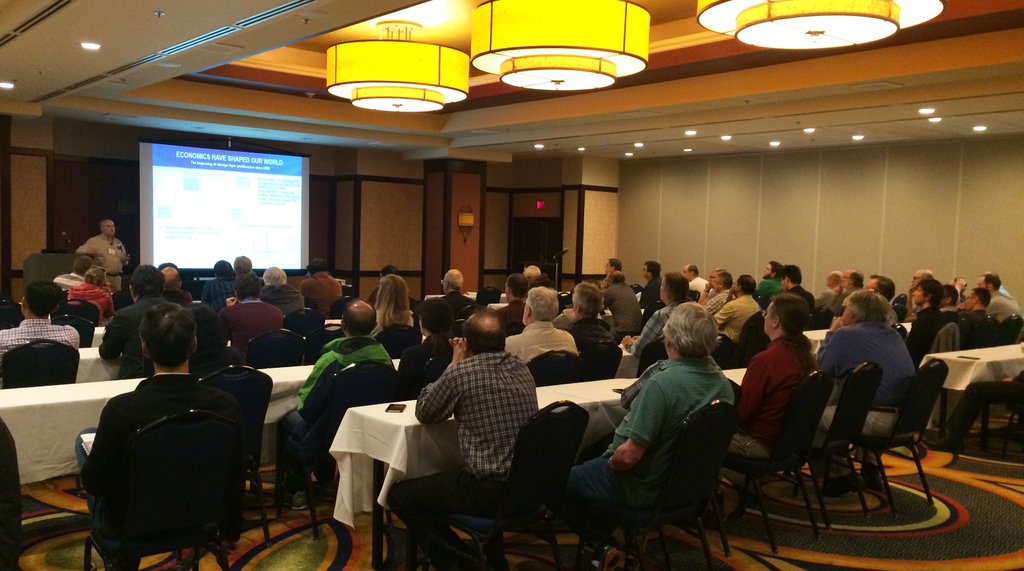
Each year, OpenFabrics Software (OFS) users and developers gather at the OpenFabrics Alliance (OFA) Workshop to discuss and tackle the most recent challenges facing the high performance storage and networking industry. OFS is an open-source software that enables maximum application efficiency and performance agnostically over RDMA fabrics, including InfiniBand and RDMA over Converged Ethernet (RoCE). The work of the OFA supports mission critical applications in High Performance Computing (HPC) and enterprise data centers, but is also quickly becoming significant in cloud and hyper-converged markets.
In our previous blog, we showcased an IBTA sponsored session that provided an update on InfiniBand virtualization support. In addition to our virtualization update, there were a handful of other notable sessions that highlighted the latest InfiniBand developments, case studies and tutorials. Below is a collection of notable InfiniBand focused sessions that we recommend you check out:
InfiniBand as Core Network in an Exchange Application
Ralph Barth, Deutsche Börse AG; Joachim Stenzel, Deutsche Börse AG
Group Deutsche Boerse is a global financial service organization covering the entire value chain from trading, market data, clearing, settlement to custody. While reliability has been a fundamental requirement for exchanges since the introduction of electronic trading systems in the 1990s, since about 10 years also low and predictable latency of the entire system has become a major design objective. Both issues have been important architecture considerations, when Deutsche Boerse started to develop an entirely new derivatives trading system T7 for its options market in the US (ISE) in 2008. As the best fit at the time a combination of InfiniBand with IBM® WebSphere® MQ Low Latency Messaging (WLLM) as the messaging solution was determined. Since then the same system has been adopted for EUREX, one of the largest derivatives exchanges in the world, and is now also extended to cover cash markets. The session presents the design of the application and its interdependence with the combination of InfiniBand and WLLM. Also practical experiences with InfiniBand in the last couple of years will be reflected upon.
Experiences in Writing OFED Software for a New InfiniBand HCA
Knut Omang, Oracle
This talk presents experiences, challenges and opportunities as lead developer in initiating and developing OFED stack support (kernel and user space driver) for Oracles InfiniBand HCA integrated in the new SPARC Sonoma SoC CPU. In addition to the physical HCA function SR/IOV is supported with vHCAs visible to the interconnect as connected to virtual switches. Individual driver instances for the vHCAs maintains page tables set up for the HCAs MMU for memory accessible from the HCA. The HCA is designed to scale to a large number of QPs. For minimal overhead and maximal flexibility, administrative operations such as memory invalidations also use an asynchronous work request model similar to normal InfiniBand traffic.
Fabrics and Topologies for Directly Attached Parallel File Systems and Storage Networks
Susan Coulter, Los Alamos National Laboratory
InfiniBand fabrics supporting directly attached storage systems are designed to handle unique traffic patterns, and they contain different stress points than other fabrics. These SAN fabrics are often expected to be extensible in order to allow for expansion of existing file systems and addition of new file systems. The character and lifetime of these fabrics is distinct from those of internal compute fabrics, or multi-purpose fabrics. This presentation covers the approach to InfiniBand SAN design and deployment as experienced by the High Performance Computing effort at Los Alamos National Laboratory.
InfiniBand Topologies and Routing in the Real World
Susan Coulter, Los Alamos National Laboratory; Jesse Martinez, Los Alamos National Laboratory
As with all sophisticated and multifaceted technologies – designing, deploying and maintaining high-speed networks and topologies in a production environment and/or at larger scales can be unwieldy and surprising in their behavior. This presentation illustrates that fact via a case study from an actual fabric deployed at Los Alamos National Laboratory.
InfiniBand Routers Premier
Mark Bloch, Mellanox Technologies; Liran Liss, Mellanox Technologies
InfiniBand has gone a long way in providing efficient large-scale high performance connectivity. InfiniBand subnets have shown to scale to tens of thousands of nodes, both in raw capacity and in management. As demand for computing capacity increases, future clusters sizes might exceed the number of addressable endpoints in a single IB subnet (around 40K nodes). To accommodate such clusters, a routing layer with the same latencies and bandwidth characteristics as switches is required.
In addition, as data center deployments evolve, it becomes beneficial to consolidate resources across multiple clusters. For example, several compute clusters might require access to a common storage infrastructure. Routers can enable such connectivity while reducing management complexity and isolating intra-subnet faults. The bandwidth capacity to storage may be provisioned as needed.
This session reviews InfiniBand routing operation and how it can be used in the future. Specifically, we will cover topology considerations, subnet management issues, name resolution and addressing, and potential implications for the host software stack and applications.
Download: Slides

